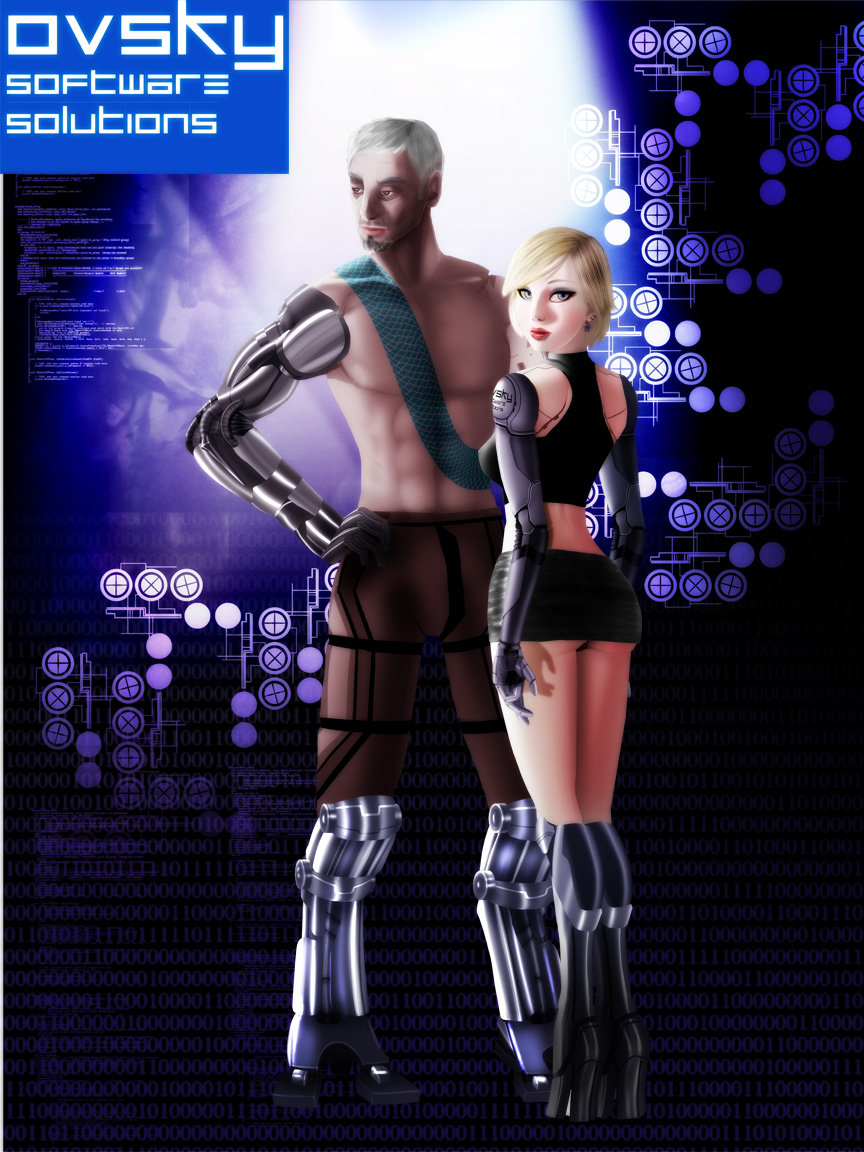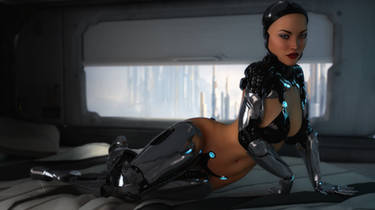ShopDreamUp AI ArtDreamUp
Deviation Actions
Description
30 DAY MONSTER GIRL CHALLENGE
day 29 - A Monster Girl and Her Significant Other (Transhumans)
:origin()/pre02/2572/th/pre/f/2012/322/9/7/transhumansb_by_raulovsky-d5lcxf3.jpg)
:origin()/pre06/edf7/th/pre/f/2012/322/1/b/transhumansc_by_raulovsky-d5lcxl5.jpg)
in this one, i´ve choosed humankind, but in a sense that always kinda obsessed me, the transhumanism... so
wikiattack
Transhumanism, abbreviated as H+ or h+, is an international intellectual and cultural movement that affirms the possibility and desirability of fundamentally transforming the human condition by developing and making widely available technologies to eliminate aging and to greatly enhance human intellectual, physical, and psychological capacities. Transhumanist thinkers study the potential benefits and dangers of emerging technologies that could overcome fundamental human limitations, as well as study the ethical matters involved in developing and using such technologies. They predict that human beings may eventually be able to transform themselves into beings with such greatly expanded abilities as to merit the label "posthuman"
Some elements of transhumanist thought and research are considered by critics to be within the realm of fringe science because it departs significantly from the mainstream. The very notion and prospect of human enhancement and related issues also arouse public controversy. Criticisms of transhumanism and its proposals take two main forms: those objecting to the likelihood of transhumanist goals being achieved (practical criticisms); and those objecting to the moral principles or world view sustaining transhumanist proposals or underlying transhumanism itself (ethical criticisms). However, these two strains sometimes converge and overlap, particularly when considering the ethics of changing human biology in the face of incomplete knowledge.
Critics or opponents often see transhumanists' goals as posing threats to human values. Some also argue that strong advocacy of a transhumanist approach to improving the human condition might divert attention and resources from social solutions. As most transhumanists support non-technological changes to society, such as the spread of civil rights and civil liberties[citation needed], and most critics of transhumanism support technological advances in areas such as communications and health care[citation needed], the difference is often a matter of emphasis. Sometimes, however, there are strong disagreements about the very principles involved, with divergent views on humanity, human nature, and the morality of transhumanist aspirations. At least one public interest organization, the U.S.-based Center for Genetics and Society, was formed, in 2001, with the specific goal of opposing transhumanist agendas that involve transgenerational modification of human biology, such as full-term human cloning and germinal choice technology. The Institute on Biotechnology and the Human Future of the Chicago-Kent College of Law critically scrutinizes proposed applications of genetic and nanotechnologies to human biology in an academic setting.
Some of the most widely known critiques of the transhumanist program refer to novels and fictional films. These works of art, despite presenting imagined worlds rather than philosophical analyses, are used as touchstones for some of the more formal arguments.
Biopolitical activist Jeremy Rifkin and biologist Stuart Newman accept that biotechnology has the power to make profound changes in organismal identity. They argue against the genetic engineering of human beings, because they fear the blurring of the boundary between human and artifact. Philosopher Keekok Lee sees such developments as part of an accelerating trend in modernization in which technology has been used to transform the "natural" into the "artifactual" In the extreme, this could lead to the manufacturing and enslavement of "monsters" such as human clones, human-animal chimeras or bioroids, but even lesser dislocations of humans and non-humans from social and ecological systems are seen as problematic.
the full article
en.wikipedia.org/wiki/Transhum…
day 29 - A Monster Girl and Her Significant Other (Transhumans)
:origin()/pre02/2572/th/pre/f/2012/322/9/7/transhumansb_by_raulovsky-d5lcxf3.jpg)
Mature Content
:origin()/pre06/edf7/th/pre/f/2012/322/1/b/transhumansc_by_raulovsky-d5lcxl5.jpg)
in this one, i´ve choosed humankind, but in a sense that always kinda obsessed me, the transhumanism... so
wikiattack
Transhumanism, abbreviated as H+ or h+, is an international intellectual and cultural movement that affirms the possibility and desirability of fundamentally transforming the human condition by developing and making widely available technologies to eliminate aging and to greatly enhance human intellectual, physical, and psychological capacities. Transhumanist thinkers study the potential benefits and dangers of emerging technologies that could overcome fundamental human limitations, as well as study the ethical matters involved in developing and using such technologies. They predict that human beings may eventually be able to transform themselves into beings with such greatly expanded abilities as to merit the label "posthuman"
Some elements of transhumanist thought and research are considered by critics to be within the realm of fringe science because it departs significantly from the mainstream. The very notion and prospect of human enhancement and related issues also arouse public controversy. Criticisms of transhumanism and its proposals take two main forms: those objecting to the likelihood of transhumanist goals being achieved (practical criticisms); and those objecting to the moral principles or world view sustaining transhumanist proposals or underlying transhumanism itself (ethical criticisms). However, these two strains sometimes converge and overlap, particularly when considering the ethics of changing human biology in the face of incomplete knowledge.
Critics or opponents often see transhumanists' goals as posing threats to human values. Some also argue that strong advocacy of a transhumanist approach to improving the human condition might divert attention and resources from social solutions. As most transhumanists support non-technological changes to society, such as the spread of civil rights and civil liberties[citation needed], and most critics of transhumanism support technological advances in areas such as communications and health care[citation needed], the difference is often a matter of emphasis. Sometimes, however, there are strong disagreements about the very principles involved, with divergent views on humanity, human nature, and the morality of transhumanist aspirations. At least one public interest organization, the U.S.-based Center for Genetics and Society, was formed, in 2001, with the specific goal of opposing transhumanist agendas that involve transgenerational modification of human biology, such as full-term human cloning and germinal choice technology. The Institute on Biotechnology and the Human Future of the Chicago-Kent College of Law critically scrutinizes proposed applications of genetic and nanotechnologies to human biology in an academic setting.
Some of the most widely known critiques of the transhumanist program refer to novels and fictional films. These works of art, despite presenting imagined worlds rather than philosophical analyses, are used as touchstones for some of the more formal arguments.
Biopolitical activist Jeremy Rifkin and biologist Stuart Newman accept that biotechnology has the power to make profound changes in organismal identity. They argue against the genetic engineering of human beings, because they fear the blurring of the boundary between human and artifact. Philosopher Keekok Lee sees such developments as part of an accelerating trend in modernization in which technology has been used to transform the "natural" into the "artifactual" In the extreme, this could lead to the manufacturing and enslavement of "monsters" such as human clones, human-animal chimeras or bioroids, but even lesser dislocations of humans and non-humans from social and ecological systems are seen as problematic.
the full article
en.wikipedia.org/wiki/Transhum…
Image size
864x1152px 360.96 KB
Comments2
Join the community to add your comment. Already a deviant? Log In
Very nice



































